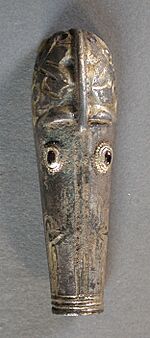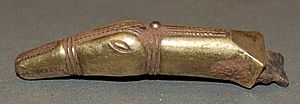Horncastle boar's head facts for kids
Quick facts for kids Horncastle boar's head |
|
|---|---|
 |
|
| Material | Silver, gold, garnets |
| Created | c. 600–650 AD |
| Discovered | 2002 Horncastle |
| Present location | The Collection, Lincoln |
The Horncastle boar's head is a cool Anglo-Saxon decoration from the early 600s. It looks like a wild pig's head. It was probably once part of the top of a helmet.
A metal detectorist found it in 2002 in the town of Horncastle, Lincolnshire, England. Because it was an old and valuable find, it was reported as 'treasure'. A museum in Lincoln, called The Collection, bought it for £15,000. You can see it there today.
What it Looks Like
This silver piece is about 40 mm (1.5 inches) long. It is shaped like a boar's head, but not totally realistic. It has a long head with a thick mane down the middle.
The boar's eyes are made of red garnet stones. Its eyebrows, skull, mouth, tusks, and snout are covered in a thin layer of gold, which is called 'gilded'. The head is hollow inside. When it was found, it was full of soil and plant roots.
Underneath, there are three small rivets. These rivets would have held the boar's head onto a larger object. Experts believe this object was most likely a helmet. This boar's head probably sat on top of a helmet as a decoration.
How it Was Found
The boar's head was found on May 1, 2002. A man named Mr. D. Turner discovered it using a metal detector. He was searching in Horncastle, a market town in Lincolnshire, England.
Because the object was more than 300 years old and contained a lot of silver, it had to be reported. This is a rule under the Treasure Act 1996 in England. It was officially declared 'treasure'.
The object was valued at £15,000. The City and County Museum in Lincoln bought it. This museum is now known as The Collection. Different groups helped pay for it, including the Art Fund. As of 2019, the boar's head is on display at The Collection. It is shown with other Anglo-Saxon items found in graves.
Boars on Helmets

This boar's head is from the Anglo-Saxon period, around the early 600s AD. We can't be totally sure what it was used for. But its style and size suggest it was the end piece of a helmet's crest.
Many helmets from this time had animal figures on their crests. For example, the Sutton Hoo helmet has dragons at each end of its crest. The Staffordshire helmet has a horse's head.
Boars were also popular on helmets. The Benty Grange helmet and the Wollaston helmet both have boars on top. The Sutton Hoo helmet and possibly the York helmet have boars at the ends of their eyebrows. The Horncastle boar looks a lot like the boar on the Benty Grange helmet. It has similar eyes, tusks, and a clear mane.
Boars were important symbols in ancient Germanic paganism. People believed boars were connected to gods and could offer protection. The Roman historian Tacitus wrote that some groups wore boar symbols for protection in battle. In the old Anglo-Saxon poem Beowulf, it says that boar symbols on helmets watched over the warriors.
The Horncastle boar's head likely decorated an early type of "crested helmet." These helmets were used in Northern Europe from the 500s to the 1000s AD. They usually had a rounded top and a crest running from the nose to the back of the neck. The Horncastle boar was probably attached to one end of this crest.


